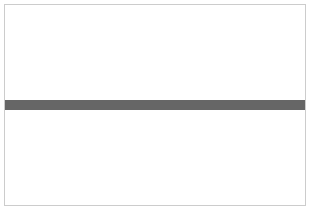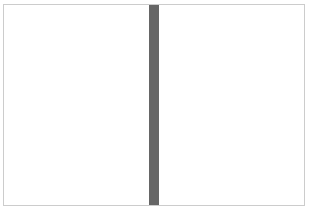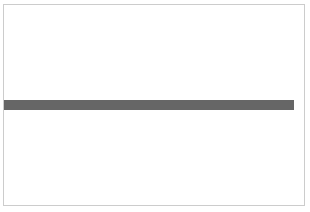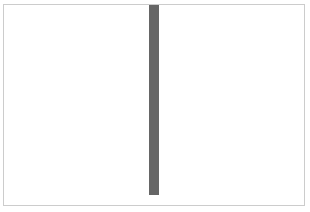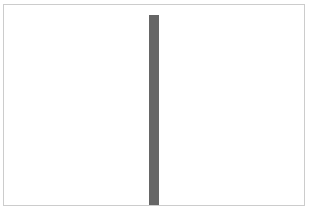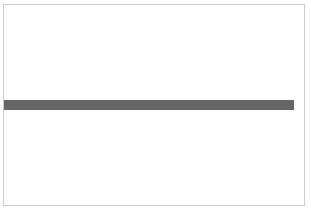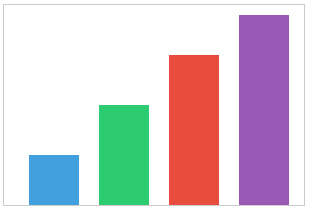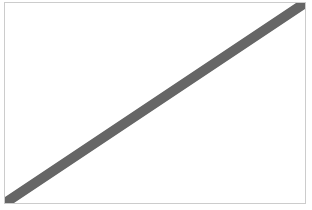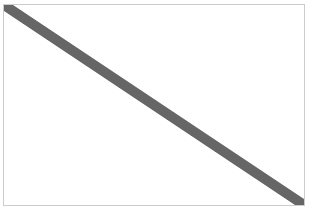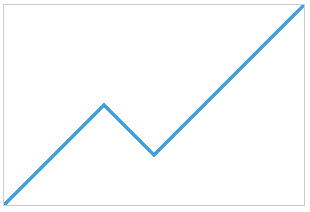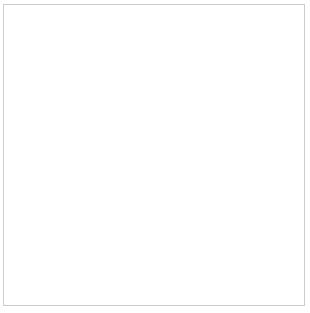はじめに
生のCanvasAPIには便利なアニメーションメソッドは無く、ただの直線でも動かそうとすると結構手間です。意外と使う気もするので、記事としてパターンをまとめてみました。何かのお役に立てば幸いです。
CanvasAPIのアニメーションについての基本イメージは以下にまとめています。
Canvasアニメーションの要点
[目次]
- はじめに
- 縦線・横線を引く
- 普通に引く
- アニメーションさせる
- 応用: イージングを付ける
- 応用: グラフっぽいものを描く
- 斜め線を引く
- 普通に引く
- アニメーションさせる
- 応用: イージングを付ける
- 応用: グラフっぽいものを描く
- 終わりに
- おまけだ...っ!
縦線・横線を引く
普通に引く
メソッドが用意されており難しいことはありません。
気をつけるポイントがあるとすれば「1pxの線を引くと太く見えることがある」ということぐらいでしょうか。
参考ページ
https://plus.google.com/102594170131511973965/posts/aiV2SqosCfR
<canvas id="myCanvas" width="300" height="200"></canvas>
// 変数定義
var cs = document.getElementById('myCanvas'),
ctx = cs.getContext('2d'),
csWidth = cs.width,
csHeight = cs.height,
center = {
x: csWidth / 2,
y: csHeight / 2
};
// 線の基本スタイル
ctx.strokeStyle = '#666';
ctx.lineWidth = 10;
// 横線を引く
var drawHorizontalLine = function() {
ctx.beginPath();
ctx.moveTo(0, center.y);
ctx.lineTo(csWidth, center.y);
ctx.closePath();
ctx.stroke();
};
// 縦線を引く
var drawVerticalLine = function() {
ctx.beginPath();
ctx.moveTo(center.x, 0);
ctx.lineTo(center.x, csHeight);
ctx.closePath();
ctx.stroke();
};
drawHorizontalLine();
drawVerticalLine();
アニメーションさせる
直線として引く座標位置をそのつど算出して描画を繰り返します。
縦・横は伸ばす座標のx, yが違うだけです。反対方向にするには、「開始終了位置」「終了条件」「加算する値」などを変更します。
// 変数定義や基本スタイルは省略(前述)
// ...
var drawHorizontalLineAnim = function() {
var beginPos = 0, // スタート位置
movePos = beginPos, // 移動位置(現在位置)
addVal = 10, // 加算量
endPos = csWidth - 10, // 終了位置
isAnim = function() { // アニメーションを終了する条件
return (movePos < endPos);
};
var render = function() {
ctx.beginPath();
ctx.moveTo(beginPos, center.y);
ctx.lineTo(movePos, center.y);
ctx.closePath();
ctx.stroke();
if (isAnim() === true) {
movePos += addVal;
// ↑のaddで終了点を超えることがあるため上限を決める
movePos = (isAnim() === false) ? endPos : movePos;
requestAnimationFrame(render)
}
};
render();
};
drawHorizontalLineAnim();
// 変数定義や基本スタイルは省略(前述)
// ...
var drawVerticalLineAnim = function() {
var beginPos = 0,
movePos = beginPos,
addVal = 10,
endPos = csHeight - 10,
isAnim = function() {
return (movePos < endPos);
};
var render = function() {
ctx.beginPath();
ctx.moveTo(center.x, beginPos);
ctx.lineTo(center.x, movePos);
ctx.closePath();
ctx.stroke();
// 描画を繰り返す条件
if (isAnim() === true) {
movePos += addVal;
// ↑のaddで終了点を超えることがあるため上限を決める
movePos = (isAnim() === false) ? endPos : movePos;
requestAnimationFrame(render)
}
};
render();
};
drawVerticalLineAnim();
// 変数定義や基本スタイルは省略(前述)
// ...
var drawVerticalLineAnimReverse = function() {
var beginPos = csHeight,
movePos = beginPos;
addVal = -10,
endPos = 10,
isAnim = function() {
return (endPos < movePos);
};
var render = function() {
ctx.beginPath();
ctx.moveTo(center.x, beginPos);
ctx.lineTo(center.x, movePos);
ctx.closePath();
ctx.stroke();
// 描画を繰り返す条件
if (isAnim() === true) {
movePos += addVal;
movePos = (isAnim() === false) ? endPos : movePos;
requestAnimationFrame(render)
}
};
render();
};
drawVerticalLineAnimReverse();
応用: イージングを付ける
イージングをつけてアニメーションに動きをつけてみます。
今までのように伸ばす値を決めて加算していくのではなく、アニメーションさせるトータルの時間と経過時間を元に現在の変化量を計算していきます。
なおイージングの計算式は以下のものを利用させていただきました。
http://gizma.com/easing/
ちょっとGifだと分かりにくいかもしれません
http://jsbin.com/yepike/
// 変数定義や基本スタイルは省略(前述)
// ...
var drawHorizontalLineAnimEase = function() {
/**
* イージング関数
* http://gizma.com/easing/
* @param {[type]} t [経過時間(ミリ秒)]
* @param {[type]} b [初期値]
* @param {[type]} c [値の変化量、10->50なら40となる]
* @param {[type]} d [アニメーション時間(ミリ秒)]
*/
var easeInQuad = function (t, b, c, d) {
t /= d;
return c*t*t + b;
};
var beginPos = 0,
movePos = beginPos,
endPos = csWidth - 10, //
changeVal = endPos - beginPos, // 値の変化量
duration = 1000, // アニメーション時間。最小でも300程度は取る
beginTime = new Date().getTime(),
// 経過時間
getTime = function() {
return (new Date().getTime() - beginTime);
},
isAnim = function() {
return (movePos < endPos);
};
var render = function() {
ctx.beginPath();
ctx.moveTo(beginPos, center.y);
ctx.lineTo(movePos, center.y);
ctx.closePath();
ctx.stroke();
if (isAnim() === true) {
movePos = easeInQuad(getTime(), beginPos, changeVal, duration);
// ↑で終了点を超えることがあるため上限を決める
movePos = (isAnim() === false) ? endPos : movePos;
requestAnimationFrame(render)
}
};
render();
};
drawHorizontalLineAnimEase();
応用: グラフっぽいものを描く
直線の数を増やしてグラフのようなものを描いてみます。
考え方は上で書いたものと同じですが、ここではConstructorを使ってカスタマイズしやすくなることを目指しました。
// 変数定義や基本スタイルは省略(前述)
// ...
var Graph = function(arg) {
this.initialize(arg);
/* 静的プロパティ */
this.addVal = -10;
this.isAnim = function() {
return (this.endPos.y < this.movePos.y);
};
};
(function (p) {
p.initialize = function(arg) {
// 左右に線が引かれるので位置に注意
this.strokeStyle = arg.strokeStyle;
this.beginPos = {
x: arg.beginPos.x,
y: arg.beginPos.y
};
this.movePos = {
x: arg.beginPos.x,
y: arg.beginPos.y
};
this.endPos = {
x: arg.endPos.x,
y: arg.endPos.y
};
};
p.draw = function() {
ctx.strokeStyle = this.strokeStyle;
ctx.beginPath();
ctx.moveTo(this.beginPos.x, this.beginPos.y);
ctx.lineTo(this.movePos.x, this.movePos.y);
ctx.closePath();
ctx.stroke();
};
p.update = function() {
this.movePos.y += this.addVal;
};
p.render = function() {
this.draw();
if (this.isAnim() === true) {
this.update();
this.movePos.y = (this.isAnim() === false) ? this.endPos.y : this.movePos.y;
requestAnimationFrame(this.render.bind(this));
}
};
})(Graph.prototype);
var graphData = [
{
strokeStyle: '#43a0de',
beginPos: { x: 50, y: 200},
endPos: { x: 50, y: 150}
},
{
strokeStyle: '#2ecc71',
beginPos: { x: 120, y: csHeight},
endPos: { x: 120, y: 100}
},
{
strokeStyle: '#e74c3c',
beginPos: { x: 190, y: csHeight},
endPos: { x: 190, y: 50}
},
{
strokeStyle: '#9b59b6',
beginPos: { x: 260, y: csHeight},
endPos: { x: 260, y: 10}
}
];
// 以降、グラフインスタンスの生成とレンダリング
var graphObj = {},
i = 0,
j = 0,
l = graphData.length;
for (; i < l; i++) {
graphObj[i] = new Graph(graphData[i]);
}
for (; j < l; j++) {
graphObj[j].render();
}
斜め線を引く
普通に引く
縦横と同じです。
// 変数定義や基本スタイルは省略(前述)
// ...
var drawSlantLine = function() {
ctx.beginPath();
ctx.moveTo(0, csHeight);
ctx.lineTo(csWidth, 0);
ctx.closePath();
ctx.stroke();
};
drawSlantLine();
アニメーションさせる
縦横とは違いx, y座標の両方を変動させます。
斜辺の線上から位置がずれると直線にならないので、進むべき角度とそれに沿った値の計算が必要です。
// 変数定義や基本スタイルは省略(前述)
// ...
var drawSlantLineAnim = function() {
var beginPos = { // 開始座標
x: 0,
y: 0
},
movePos = { // 移動座標(現在のxy座標)
x: beginPos.x,
y: beginPos.y
},
endPos = { // 終了座標
x: csWidth,
y: csHeight
},
moveLength = 0, // 移動距離(現在の移動距離)
addLength = 10, // 移動する距離
side = { // 移動する範囲の辺の長さ
x: endPos.x - beginPos.x,
y: endPos.y - beginPos.y
},
// beginPos -> endPosに伸びていく斜辺の角度を算出
// ラジアン = Math.atan2(終y座標 - 始y座標, 終x座標 - 始x座標);
// 角度 = ラジアン * 180 / Math.PI;
hypotenuse = Math.sqrt(Math.pow(side.x, 2) + Math.pow(side.y, 2)),
radian = Math.atan2(side.y, side.x),
isAnim = function() {
// 移動した距離が斜辺の長さを超えていないかどうか
return moveLength < hypotenuse;
};
var render = function() {
ctx.beginPath();
ctx.moveTo(beginPos.x, beginPos.y);
ctx.lineTo(movePos.x, movePos.y);
ctx.closePath();
ctx.stroke();
if (isAnim() === true) {
moveLength += addLength;
movePos.x += Math.cos(radian) * addLength;
movePos.y += Math.sin(radian) * addLength;
// ↑のaddで終了点を超えることがあるため上限を決める
movePos.x = (isAnim() === false) ? endPos.x : movePos.x;
movePos.y = (isAnim() === false) ? endPos.y : movePos.y;
requestAnimationFrame(render);
}
};
render();
};
drawSlantLineAnim();
応用: イージングを付ける
イージングを付けてみます。
変化中の値を計算する必要がなく、単純なものであればこちらの方が簡単かもしれません。
ちょっとGifだと分かりにくいかもしれません
http://jsbin.com/lipaqa
// 変数定義や基本スタイルは省略(前述)
// ...
var drawSlantLineAnimEase = function() {
/**
* イージング関数
* http://gizma.com/easing/
* @param {[type]} t [経過時間(ミリ秒)]
* @param {[type]} b [初期値]
* @param {[type]} c [値の変化量、10->50なら40となる]
* @param {[type]} d [アニメーション時間(ミリ秒)]
*/
var easeInQuad = function (t, b, c, d) {
t /= d;
return c*t*t + b;
};
var beginPos = { // 開始座標
x: 0,
y: 0
},
movePos = { // 移動座標(現在のxy座標)
x: beginPos.x,
y: beginPos.y
},
endPos = { // 終了座標
x: csWidth,
y: csHeight
},
side = { // 移動する範囲の辺の長さ
x: endPos.x - beginPos.x,
y: endPos.y - beginPos.y
},
duration = 1000, // アニメーション時間。最小でも300程度は取る
beginTime = new Date().getTime(),
// 経過時間
getTime = function() {
return (new Date().getTime() - beginTime);
},
isAnim = function() {
// アニメーション時間が超えていないかどうか
return getTime() < duration;
};
var render = function() {
var draw = function() {
ctx.clearRect(0, 0, csWidth, csHeight);
ctx.beginPath();
ctx.moveTo(beginPos.x, beginPos.y);
ctx.lineTo(movePos.x, movePos.y);
ctx.closePath();
ctx.stroke();
};
if (isAnim() === true) {
movePos.x = easeInQuad(getTime(), beginPos.x, side.x, duration);
movePos.y = easeInQuad(getTime(), beginPos.y, side.y, duration);
draw();
requestAnimationFrame(render);
} else {
// 経過時間で条件を判断しているため、requestAnimationFrameだと微妙にずれる可能性がある
// 足りない分を1回再描画して補う
movePos.x = (isAnim() === false) ? endPos.x : movePos.x;
movePos.y = (isAnim() === false) ? endPos.y : movePos.y;
draw();
}
};
render();
};
drawSlantLineAnimEase();
応用: グラフっぽいものを描く
斜め線でグラフのようなものを描いてみます。
縦線グラフの時と考え方は同じですが、更にDeferredを使って順番にアニメーションできるようにしてみました。
var cs = document.getElementById('myCanvas'),
ctx = cs.getContext('2d'),
csWidth = cs.width,
csHeight = cs.height,
center = {
x: csWidth / 2,
y: csHeight / 2
};
// 線の共通スタイル
ctx.strokeStyle = '#43a0de';
ctx.lineWidth = 3;
ctx.lineJoin = 'round';
var Graph = function(arg) {
this.initialize(arg);
/* 共通の静的プロパティ */
this.moveLength = 0;
this.addLength = 5;
this.isAnim = function() {
return (this.moveLength < this.hypotenuse);
};
};
(function (p) {
/**
* インスタンスごとの初期設定
* @param {array.obj} arg [beginPos.x, beginPos.y, endPos.x, endPos.y]
*/
p.initialize = function(arg) {
this.dfd = $.Deferred();
this.beginPos = {
x: arg.beginPos.x,
y: arg.beginPos.y
};
this.movePos = {
x: arg.beginPos.x,
y: arg.beginPos.y
};
this.endPos = {
x: arg.endPos.x,
y: arg.endPos.y
};
this.side = {
x: this.endPos.x - this.beginPos.x,
y: this.endPos.y - this.beginPos.y
};
this.hypotenuse = Math.sqrt(Math.pow(this.side.x, 2) + Math.pow(this.side.y, 2));
this.radian = Math.atan2(this.side.y, this.side.x);
};
p.draw = function() {
ctx.beginPath();
ctx.moveTo(this.beginPos.x, this.beginPos.y);
ctx.lineTo(this.movePos.x, this.movePos.y);
ctx.closePath();
ctx.stroke();
};
p.update = function() {
this.moveLength += this.addLength;
this.movePos.x += Math.cos(this.radian) * this.addLength;
this.movePos.y += Math.sin(this.radian) * this.addLength;
};
p.render = function() {
this.draw();
if (this.isAnim() === true) {
this.update();
this.movePos.x = (this.isAnim() === false) ? this.endPos.x : this.movePos.x;
this.movePos.y = (this.isAnim() === false) ? this.endPos.y : this.movePos.y;
requestAnimationFrame(this.render.bind(this));
} else {
// アニメーションが完了したら通知する
this.dfd.resolve();
}
return this.dfd.promise();
};
})(Graph.prototype);
var graphData = [
{
beginPos: { x: 0, y: csHeight},
endPos: { x: 100, y: 100}
},
{
beginPos: { x: 100, y: 100},
endPos: { x: 150, y: 150}
},
{
beginPos: { x: 150, y: 150},
endPos: { x: csWidth, y: 0}
}
];
// 以降、グラフインスタンスの生成とレンダリング
var graphObj = {},
i = 0,
j = 0,
l = graphData.length;
for (; i < l; i++) {
graphObj[i] = new Graph(graphData[i]);
}
$(function() {
var d = (new $.Deferred()).resolve();
$.each(graphObj, function(i, obj){
d = d.then(function() {
return obj.render();
});
});
})
終わりに
思いのほかボリュームが出てしまったので、今回は直線のみを取り上げました。
作り方は自分で考えてみたので、書き方が微妙だったり非効率な可能性があります。もっと良い方法があればご教授くださいませ。
おまけだ...っ!
ククク...!
なんて無意味で非効率...っ!
(途中で飽きた)
